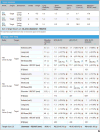Quantitative Radiology Reporting in Oncology: Survey of Oncologists and Radiologists
- PMID: 26295661
- PMCID: PMC5697144
- DOI: 10.2214/AJR.14.14054
Quantitative Radiology Reporting in Oncology: Survey of Oncologists and Radiologists
Abstract
Objective: Tumor quantification is essential for determining the clinical efficacy and response to established and evolving therapeutic agents in cancer trials. The purpose of this study was to seek the opinions of oncologists and radiologists about quantitative interactive and multimedia reporting.
Subjects and methods: Questionnaires were distributed to 253 oncologists and registrars and to 35 radiologists at our institution through an online survey application. Questions were asked about current reporting methods, methods for Response Evaluation Criteria in Solid Tumors (RECIST) tumor measurement, and preferred reporting format.
Results: The overall response rates were 43.1% (109/253) for oncologists and 80.0% (28/35) for radiologists. The oncologists treated more than 40 tumor types. Most of the oncologists (65.7% [67/102]) and many radiologists (44.4% [12/27]) (p = 0.020) deemed the current traditional qualitative radiology reports insufficient for reporting tumor burden and communicating measurements. Most of the radiologists (77.8% [21/27]) and oncologists (85.5% [71/83]) (p = 0.95) agreed that key images with measurement annotations helped in finding previously measured tumors; however, only 43% of radiologists regularly saved key images. Both oncologists (64.2% [70/109]) and radiologists (67.9% [19/28]) (p = 0.83) preferred the ability to hyperlink measurements from reports to images of lesions as opposed to text-only reports. Approximately 60% of oncologists indicated that they handwrote tumor measurements on RECIST forms, and 40% used various digital formats. Most of the oncologists (93%) indicated that managing tumor measurements within a PACS would be superior to handwritten data entry and retyping of data into a cancer database.
Conclusion: Oncologists and radiologists agree that quantitative interactive reporting would be superior to traditional text-only qualitative reporting for assessing tumor burden in cancer trials. A PACS reporting system that enhances and promotes collaboration between radiologists and oncologists improves quantitative reporting of tumors.
Keywords: productivity; quality improvement; radiology reports; tumor metrics; work flow.
Figures









References
-
- Röntgen WK. Eine neue Art von Strahlen. Würzburg, Germany: Medicophysical Institute of the University of Würzburg; 1896.
-
- Reiner BI, Knight N, Siegel EL. Radiology reporting, past, present, and future: the radiologist’s perspective. J Am Coll Radiol. 2007;4:313–319. - PubMed
-
- Danton GH. Radiology reporting: changes worth making are never easy. Appl Radiol. 2010;39:19–23.
-
- Baker SR. The dictated report and the radiologist’s ethos: an inextricable relationship—pitfalls to avoid. Eur J Radiol. 2014;83:236–238. - PubMed
-
- Jaffe TA, Wickersham NW, Sullivan DC. Quantitative imaging in oncology patients. Part 1. Radiology practice patterns at major U.S. cancer centers. AJR. 2010;195:101–106. - PubMed
Publication types
MeSH terms
Grants and funding
LinkOut - more resources
Full Text Sources
Other Literature Sources

